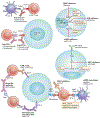Immunotherapeutic approaches for small-cell lung cancer
- PMID: 32055013
- PMCID: PMC7212527
- DOI: 10.1038/s41571-019-0316-z
Immunotherapeutic approaches for small-cell lung cancer
Abstract
Immune-checkpoint inhibitors (ICIs) are approved in the first-line and third-line settings for patients with extensive-stage or relapsed small-cell lung cancer (SCLC), respectively. In the first-line setting, the addition of the anti-programmed cell death 1 ligand 1 (PD-L1) antibody atezolizumab to chemotherapy improves overall survival (OS). In patients with relapsed disease, data from nonrandomized trials have revealed promising responses, although a significant improvement in OS over that obtained with conventional chemotherapy was not achieved in a randomized trial in this setting. Substantial research interest exists in identifying predictive biomarkers that could guide the use of ICIs in patients with SCLC. PD-L1 expression is typically low or absent in SCLC, which has precluded its use as a predictive biomarker. Tumour mutational burden might have some predictive value, although blood-based measures of tumour mutational burden did not have predictive value in patients receiving atezolizumab plus chemotherapy in the first-line setting. After three decades, ICIs have finally enabled an improvement in OS for patients with SCLC; however, a substantial amount of research remains to be done, including identifying the optimal therapeutic strategy and predictive biomarkers. In this Review, we describe the available data on clinical efficacy, the emerging evidence regarding biomarkers and ongoing clinical trials using ICIs and other immunotherapies in patients with SCLC.
Conflict of interest statement
Competing interests
W.T.I. has acted as a consultant for Defined Health, Genentech and Outcomes Insights. L.H. reports clinical trial funding from BMS, Boehringer Ingelheim and Xcovery; and has acted as a consultant for AbbVie, AstraZeneca, EMD Serono, Incyte, Merck, Pfizer, Roche-Genentech, Tesaro and Xcovery. J.P declares no competing interests.
Figures


Similar articles
-
There and back again: An immunotherapy tale.J Thorac Cardiovasc Surg. 2018 Apr;155(4):1771-1774. doi: 10.1016/j.jtcvs.2017.11.102. Epub 2017 Dec 23. J Thorac Cardiovasc Surg. 2018. PMID: 29409610 No abstract available.
-
Systemic Therapy of Extensive Stage Small Cell Lung Cancer in the Era of Immunotherapy.Curr Treat Options Oncol. 2020 Jun 29;21(8):64. doi: 10.1007/s11864-020-00762-8. Curr Treat Options Oncol. 2020. PMID: 32601742 Review.
-
Use of Immunotherapy in Extensive-Stage Small Cell Lung Cancer.Oncology. 2020;98(11):749-754. doi: 10.1159/000508516. Epub 2020 Jul 14. Oncology. 2020. PMID: 32663833 Review.
-
Predictive effect of PD-L1 expression for immune checkpoint inhibitor (PD-1/PD-L1 inhibitors) treatment for non-small cell lung cancer: A meta-analysis.Int Immunopharmacol. 2020 Mar;80:106214. doi: 10.1016/j.intimp.2020.106214. Epub 2020 Jan 23. Int Immunopharmacol. 2020. PMID: 31982822
-
KEYNOTE-024: Unlocking a pathway to lung cancer cure?J Thorac Cardiovasc Surg. 2018 Apr;155(4):1777-1780. doi: 10.1016/j.jtcvs.2017.10.155. Epub 2017 Dec 23. J Thorac Cardiovasc Surg. 2018. PMID: 29395215 No abstract available.
Cited by
-
Pathologic responses to neoadjuvant chemoimmunotherapy in primary limited-stage small-cell lung cancer.Thorac Cancer. 2022 Nov;13(22):3208-3216. doi: 10.1111/1759-7714.14679. Epub 2022 Oct 8. Thorac Cancer. 2022. PMID: 36208136 Free PMC article.
-
Immune-related pneumonitis associated with immune checkpoint inhibitors in lung cancer: a network meta-analysis.J Immunother Cancer. 2020 Aug;8(2):e001170. doi: 10.1136/jitc-2020-001170. J Immunother Cancer. 2020. PMID: 32863271 Free PMC article.
-
Molecular subtyping of small-cell lung cancer based on mutational signatures with different genomic features and therapeutic strategies.Cancer Sci. 2023 Feb;114(2):665-679. doi: 10.1111/cas.15606. Epub 2022 Oct 28. Cancer Sci. 2023. PMID: 36178064 Free PMC article.
-
Nemvaleukin alfa, a novel engineered IL-2 fusion protein, drives antitumor immunity and inhibits tumor growth in small cell lung cancer.J Immunother Cancer. 2022 Sep;10(9):e004913. doi: 10.1136/jitc-2022-004913. J Immunother Cancer. 2022. PMID: 36472839 Free PMC article.
-
The benefits and risks of pembrolizumab in combination with chemotherapy as first-line therapy in small-cell lung cancer: a single-arm meta-analysis of noncomparative clinical studies and randomized control trials.World J Surg Oncol. 2021 Oct 14;19(1):298. doi: 10.1186/s12957-021-02410-3. World J Surg Oncol. 2021. PMID: 34645484 Free PMC article. Review.
References
-
- Bernhardt EB & Jalal SI Small cell lung cancer. Cancer Treat. Res 170, 301–322 (2016). - PubMed
-
- Gazdar AF & Minna JD Developing new, rational therapies for recalcitrant small cell lung cancer. J. Natl Cancer Inst 108, djw119 (2016). - PubMed
-
- Horn L et al. First-line atezolizumab plus chemotherapy in extensive-stage small-cell lung cancer. N. Engl. J. Med 379, 2220–2229 (2018). - PubMed
-
- Antonia SJ et al. Nivolumab alone and nivolumab plus ipilimumab in recurrent small-cell lung cancer (CheckMate 032): a multicentre, open-label, phase 1/2 trial. Lancet Oncol. 17, 883–895 (2016). - PubMed
Publication types
MeSH terms
Substances
Grants and funding
LinkOut - more resources
Full Text Sources
Other Literature Sources
Medical
Research Materials

